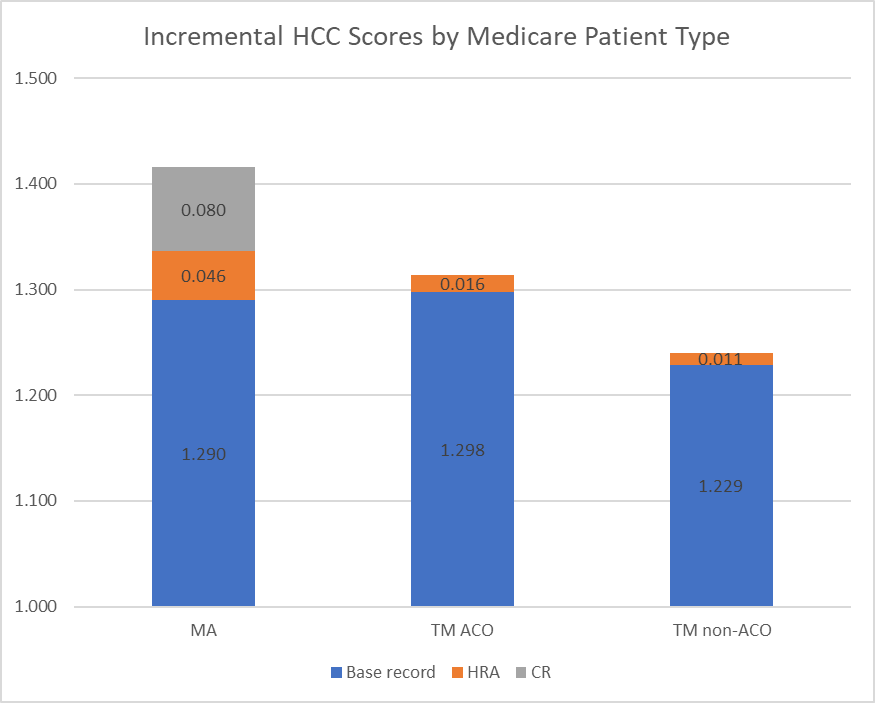To account for variations in illness burden throughout a Medicare Benefit (MA) plans affected person inhabitants, makes use of danger adjustment primarily based on affected person illness burden. Particularly, MedPAC notes that:
Medicare makes use of beneficiaries’ traits, resembling age and prior well being situations, and a risk-adjustment mannequin—the CMS hierarchical situation classes (CMS– HCCs)—to develop a measure of their anticipated relative danger for lined Medicare spending.
In February 2023, CMS CMS revealed a discover of proposed rulemaking to replace their HCC danger adjustment algorithm (v28). These modifications included (i) leveraging ICD-10 reasonably than ICD-9 codes as the first constructing blocks, (ii) use of 115 HCC indicators reasonably than 79, and (iii) constraining some coefficients to be similar throughout severity ranges (e.g., diabetes, coronary heart failure). The brand new algorithm can be phased in throughout 2024–2026.
One key query is whether or not suppliers underneath conventional Medicare (TM) code otherwise than Medicare Benefit (MA) plans. As a result of MA plan fee from CMS depends upon affected person severity, there may be an incentive to up-code diagnoses. A paper by Carlin et al. (2024) goals to guage whether or not or not this happens. They first clarify the mechanism via which MA plans might extra absolutely seize affected person secondary diagnoses:
MA plans have a possibility to evaluation medical information to make sure that suppliers didn’t by chance omit a analysis from encounter information. These opinions are extra vital when the suppliers’ reimbursement doesn’t incent detailed coding of the sufferers’ secondary diagnoses. MA plans to make corrections so as to add or (hardly ever) delete a analysis via CR information. As well as, each MA and TM suppliers could report further diagnoses via a HRA [health risk assessment] throughout a wellness go to or a house go to for this objective.
The authors use 2019 CMS claims knowledge and divide the information into 3 cohorts: MA plans, TM beneficiaries attributed to ACOs (“TM ACO”), and TM beneficiaries not attributed to an ACO (“TM non-ACO”). ACO consists of sufferers attributable to accountable care organizations (ACO), resembling these collaborating within the Medicare Shared Financial savings Program (MSSP). The authors notice that the TM non-ACO cohort serves as a key comparability since they aren’t topic to the identical coding depth incentives skilled by MA plans and TM ACOs (since ACO shared financial savings is also danger adjusted).
The authors determine sufferers who had a HRA primarily based on whether or not they had an annual wellness go to, preliminary preventive bodily examination, or chosen dwelling well being visits (following the Reid et al. 2020 algorithm). The authors additionally use data from encounter claims on whether or not a affected person chart evaluation befell. Utilizing these knowledge, the authors propensity-score matched the MA, TM ACO, and TM non-ACO cohorts. The authors then evaluate the matched and unmatched HCC scores and evaluated how the HRA and CR visits impacted the HCC danger scores. They discover:
Incremental well being danger as a consequence of diagnoses in HRA information elevated throughout protection cohorts in step with incentives to maximise danger scores:+0.9% for TM non-ACO,+1.2% for TM ACO, and+3.6% for MA. Together with HRA and CR information, the MA danger scores elevated by 9.8% within the matched cohort.

Analysis codes associated to vascular situations, congestive coronary heart failure, and diabetes had the most important contribution to common HCC rating throughout all 3 cohorts. Vascular, pscyh, and congestive coronary heart failure had been most probably to extend as a consequence of HRA/CR coding depth actions.
Whereas different papers have claimed Medicare Benefit have upcoded diagnoses for extra favorable reimbursement, this paper clearly specifies not solely the magnitude of the affect, but additionally the mechanism via which it’s most probably to happen. You possibly can learn the total paper right here.

